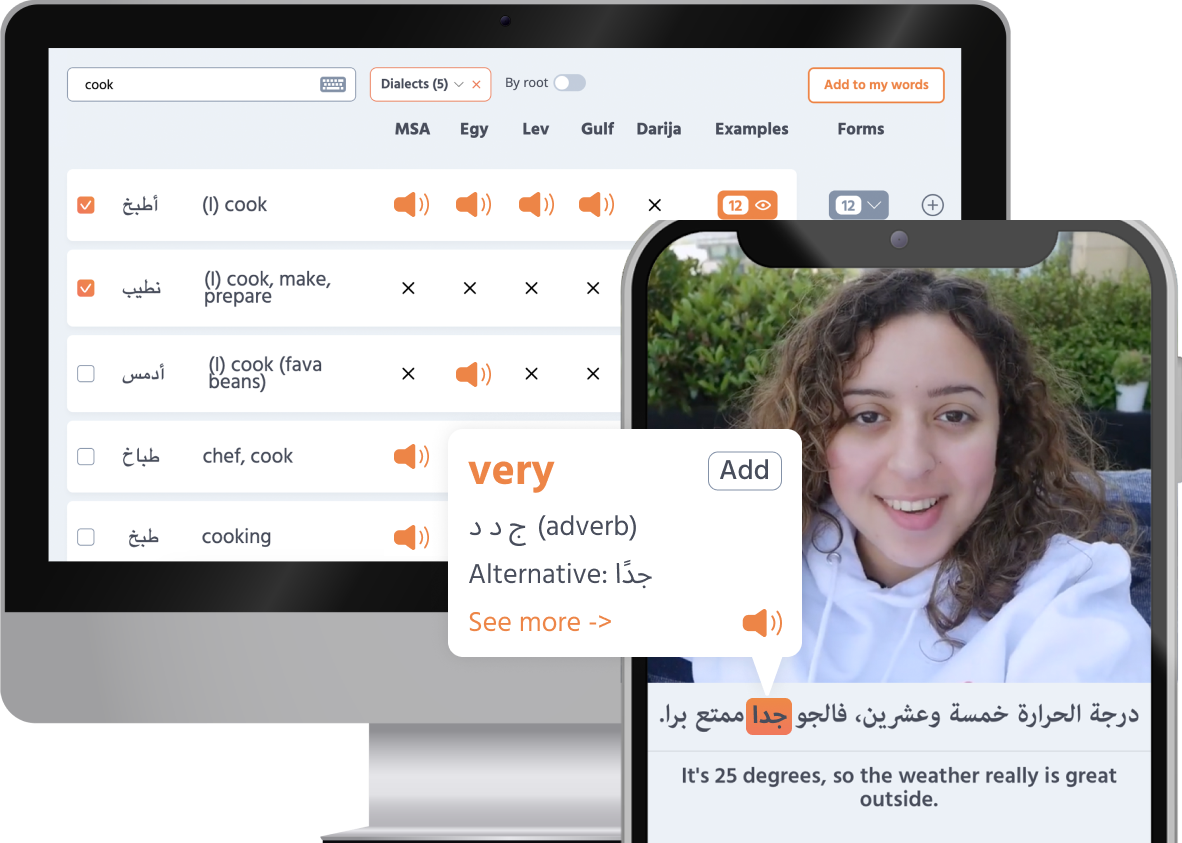Levantine Arabic
With Playaling, learning is easy, straightforward and fun. Master Levantine Arabic with real world videos!
Are you looking to learn Levantine Arabic? You’ve come to the right place! Playaling is the ultimate destination for learning the Levantine dialect with real world videos. Discover what makes the Levantine dialect unique and exciting, and embark on your journey to learn Levantine Arabic in an inspiring style.
Approximately 50 million people speak the Levantine dialect, including all residents of the Levant region, which includes Syria, Lebanon, Jordan, and Palestine. The Levantine dialect is understood by other Arabs, firstly due to its proximity to Modern Standard Arabic, and secondly because of the popularity of Syrian TV series throughout the Arab world. This has made the Levantine dialect familiar and generally understood by Arabs.
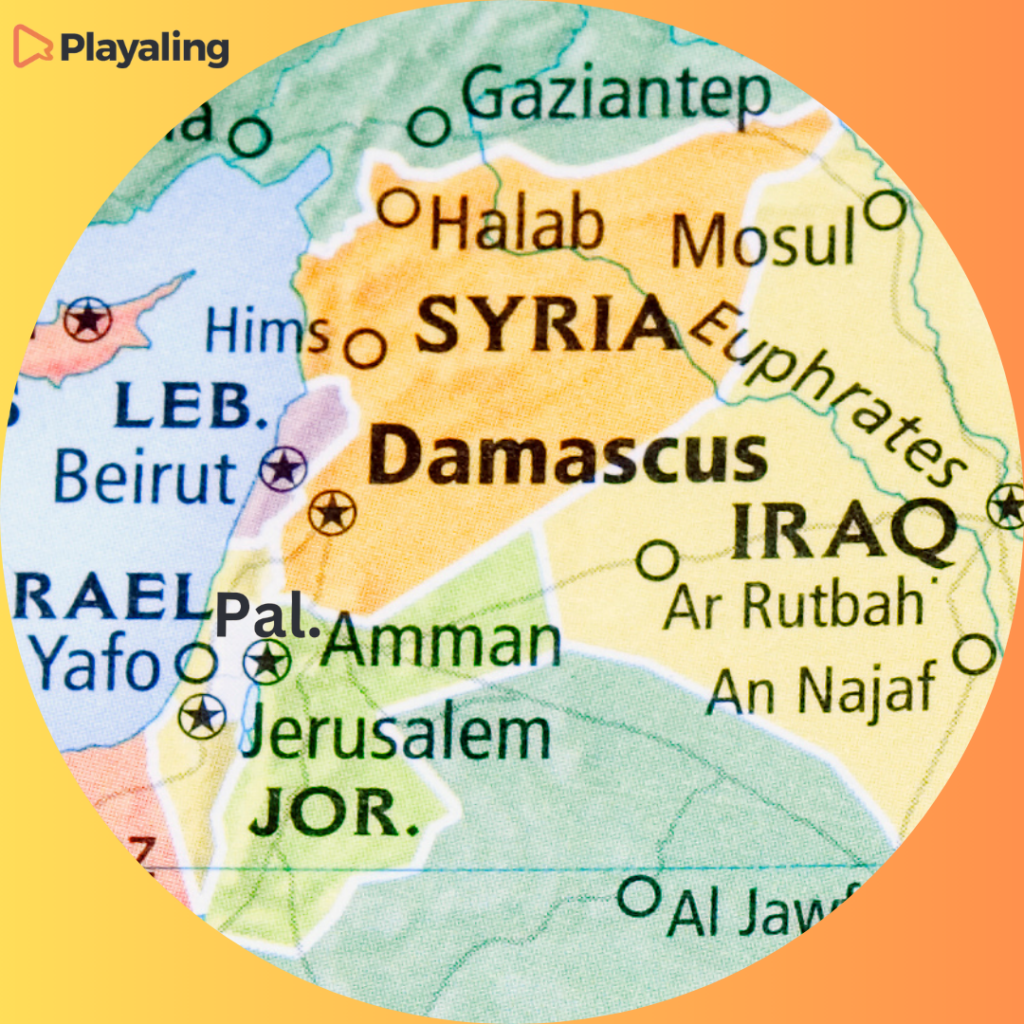
The Levantine dialect emerges from the linguistic evolution from Aramaic to Arabic within the region (both languages belong to the Semitic language family). It is divided into the Northern Levantine sub-dialect (in Syria and Lebanon) and the Southern Levantine sub-dialect (in Palestine and Jordan). However, there is no clear distinction between the two sub-dialects. For instance, certain areas in southwestern Syria and specific regions in Lebanon speak the Southern Levantine dialect, while some locales in Palestine and Jordan exhibit characteristics of the Northern Levantine dialect. Therefore, the division between the Northern and Southern dialects is somewhat fluid, with the primary distinctions across the Levant lying in small nuances of pronunciation rather than in fundamental linguistic differences.
How to learn Levantine Arabic online?
Arabic dialects differ from Modern Standard Arabic in general, but the Levantine dialect is considered one of the closest in terms of vocabulary, grammar, and pronunciation to Modern Standard Arabic. This makes learning Levantine (Shami) easier for those familiar with Modern Standard Arabic.
To learn Shami Arabic, it is important to follow these steps:
Learn the basics of Modern Standard Arabic (primarily the alphabet)
When you want to learn Shami Arabic, it is useful, but not necessary, to start by learning the basics of Modern Standard Arabic, such as the alphabet and general rules. While learning through listening can be effective, it becomes even better when accompanied by writing what we hear and understanding its meaning.
Watch real world Levantine (Shami) Arabic videos
With realistic daily conversations between Levantine people. These videos include common words and phrases, made fully accessible through interactive captioning.
Learn how to pronounce Levantine Arabic letters and words
Learning how to read and pronounce Levantine Arabic is an essential step. This can be accomplished with the help of our unique cross-dialectical Audio Dictionary, which helps you pronounce any word in any variety of Arabic you prefer and use them in context.
Strengthen your listening skills
This will help you easily understand Levantine speakers: You can practice this through Cloze Listen, an activity that helps you enhance your listening skills by writing the missing words or choosing them from a word box and placing them in blanks.
Immerse yourself in the culture of the Levant region
Understanding the culture of the Levant region is crucial for engaging with the community of that region and learning the language. If you’re eager to learn Levantine Arabic, immersing yourself in the cultural and artistic productions of the Levant region, including theater, series, and songs in the Levantine dialect, will greatly enhance your grasp of both the language and the local culture.
Here are a few videos from the series:
Repeat, review, and persevere
Learning Levantine Arabic is not easy or quick, so you always need repetition, review, and continuous learning to achieve satisfactory results. You can easily do this through comprehension check exercises available in some Playaling videos, allowing you to answer some questions while watching the video with interactive captioning to ensure your understanding. Additionally, you can review what you heard and repeat it for additional practice.
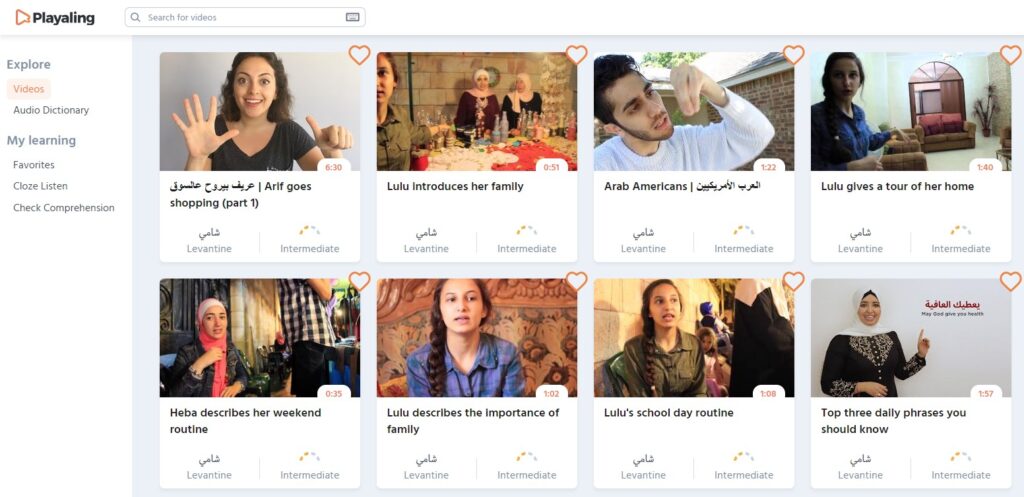
At the very beginning, is suggested to start with:
Common Levantine greeting phrases
Learning greetings helps you start the path to fluency in Levantine Arabic. Playaling is the best choice for learning these phrases through videos taken from daily life, allowing you to see how speakers of this dialect communicate in their daily lives.
Learn common Shami dialect daily phrases
Such as asking about well-being, the weather, expressing gratitude, seeking permission, apologizing, and more. Playaling focuses on these phrases in its videos, accompanied by transcripts and exercises to reinforce what you learn from the words and expressions in the videos.
Examples of videos for learning greetings and common expressions include:
- Introductions 3 (Heather and Ali) | التعارف
- Introductions 2 (Levantine and MSA) | التعارف
- Introductions 4 | التعارف
- Introductions 5 | التعارف
Why is Playaling the best platform for learning Levantine Arabic online?
As highlighted above, when looking to learn Shami Arabic online, it is essential to focus on listening, speaking, and writing skills. Playaling provides you with all these skills on a silver platter. You can practice listening skills using the audio dictionary or watching real world videos; writing skills through exercises accompanying the videos; and speaking skills by repeating what you heard and read in the videos, especially those containing dialogues from everyday life. What are you waiting for? Learn Levantine Arabic with relative ease by signing up for a free trial with Playaling today.
The Difference Between Levantine Dialect and Classical Arabic:
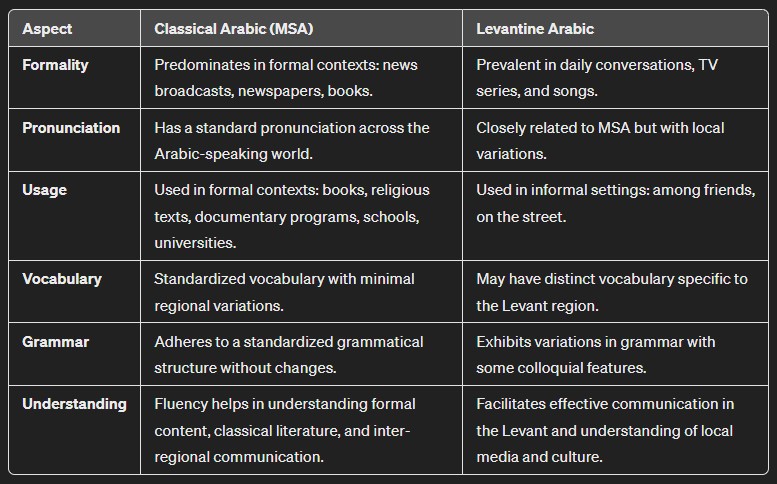
Formality
Unlike colloquial Arabic dialects, Classical Arabic predominates in formal contexts such as news broadcasts, newspapers, and books.
On the other hand, the Levantine dialect is prevalent in daily conversations among people and in television series and songs.
Pronunciation
Local dialects often differ in pronunciation from Classical Arabic, but the spoken Levantine dialect is closely related to Classical Arabic pronunciation. This is good news for those among you who know some MSA, and are interested in taking your Arabic to the next level by learning Levantine!
Usage
Classical Arabic is used in formal contexts such as books, religious texts, documentary programs, and at some schools and universities.
Levantine dialect of Arabic is used in informal settings, like with friends or on the street.
Vocabulary
MSA has a standardized vocabulary shared across the Arabic-speaking world, with minimal regional variations.
The Levantine dialect may have distinct vocabulary and expressions that are specific to the Levant region.
Grammar
MSA adheres to a standardized grammatical structure, there are basically no changes, and it is formalized. The Levantine dialect exhibits variations in grammar compared to MSA, with some colloquial features.
Understanding
Fluency in MSA helps in understanding formal Arabic content, classical literature, and communication with speakers from different Arabic-speaking regions. Proficiency in the Levantine dialect facilitates effective communication in the Levant region and allows understanding of local media and cultural expressions
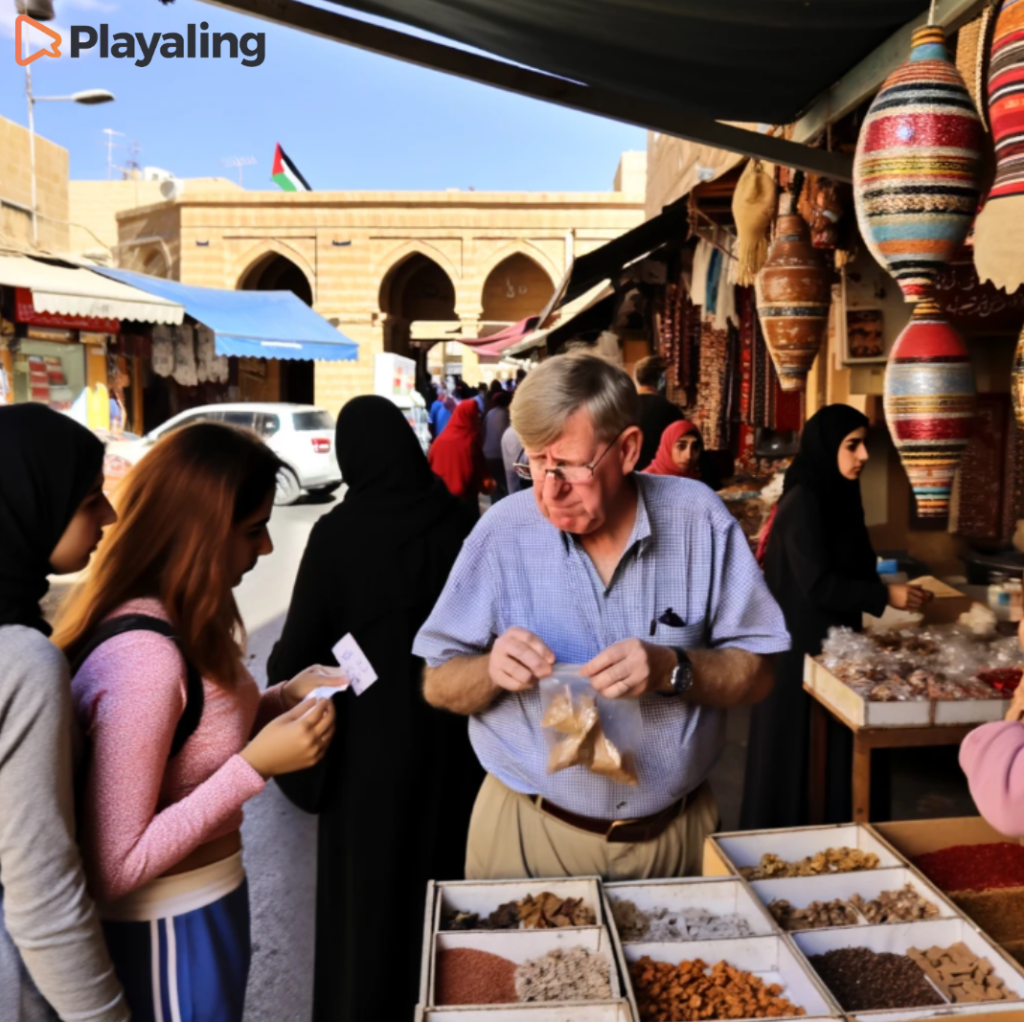
In summary, while Modern Standard Arabic serves as a formal, standardized version of the language, the Levantine dialect is a spoken, region-specific variant used in informal contexts within the Levant region, encompassing countries like Syria, Lebanon, Jordan, and Palestine. Learning Levantine, or any regional dialects as well as MSA provides a well-rounded understanding of Arabic as spoken in different regions.
The following chart shows some basic sentences in different varieties of Arabic, one version for addressing males and one version for addressing females. In each row, the masculine version is listed on top; the feminine version is listed on bottom.
| English | How are you? | Where are you from? | What is your name? | What time is it? | I love you |
| MSA | كَيْفَ حَالُكَ؟ كَيْفَ حَالُكِ؟ | مِن أَيْنَ أنتَ؟ مِن أينَ أنتِ؟ | مَا اِسْمُكَ؟ مَا اِسْمُكِ؟ | كَمْ السّاعَة؟ | أُحِبُّكَ أُحِبُّكِ |
| Levantine | كِيفَك؟ كِيفِك؟
| مِنْ وِينْ اِنْتَ؟ مِنْ وِينْ اِنْتِ؟ |
شُو اِسْمَك؟ شُو اِسْمِك؟
| قَدِّيشْ السّاعَة؟ | بْحِبَّك بْحِبِّك |
Unlock Levantine Arabic: Explore, learn, enjoy with Playaling!
If you are interested in living in the Levant region or simply want to speak Levantine Arabic like a local, we would highly suggest connecting with individuals from this area. Playaling is the best method to guide you through the journey of learning the Levantine dialect and the Arabic language without feeling bored. Embark on the adventure to learn Levantine Arabic by subscribing to Playaling and immersing yourself in all the features available to you without limits during the one-week free trial. We wish you an enjoyable and real-world-inspired experience with learning Levantine dialect while virtually immersing yourself in the region!
Table of Contents
Links
Links

